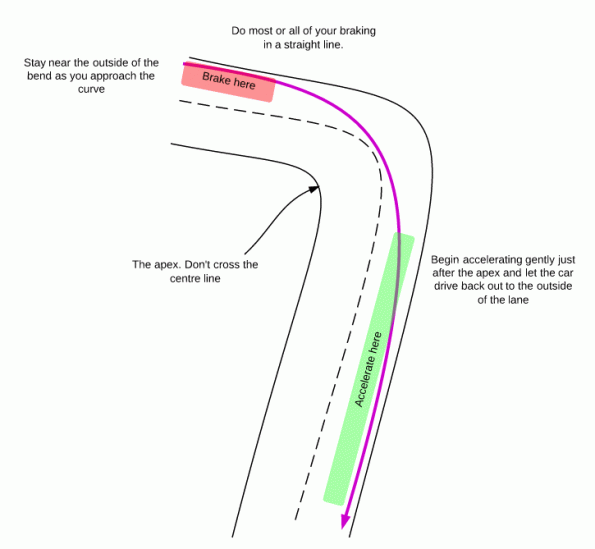Driving smoothly is one of the easiest skills to learn and do, but many of us fall into bad habits, or perhaps aren’t taught. If you can drive smoothly you will use less fuel, not wear your brakes out as quickly, cause less wear and tear on your car, keep your passengers more comfortable, and potentially get there quicker and more refreshed.
The key part of driving smoothly is the line you take through the corners. Take a look at this diagram.

This diagram shows the racing line, which is one of two main ways of driving through a corner. You’ll see that approaching a right-hand bend that you position your vehicle on the left of the lane. You don’t want your wheels running on the verge, but I usually aim to have my left wheels just touching the left line on the road.
Do the majority of your braking while you are approaching the corner on the straight. You can leave a little braking until after you’ve turned in, but you don’t want to be slowing down rapidly while you’re in the corner because you’ll load up the outside wheels with extra g-forces, and it’ll be not quite so comfortable for your passengers.
So, you’ll come off the brakes as you turn in towards the apex of the turn and if it’s a short corner you’ll probably coast to the apex if you need to scrub off a little more speed, or if it’s a longer corner then you might need to use the accelerator to maintain speed. The apex is the centre of the turn and the point at which your vehicle is the closest to the inside. Some corners might have two apexes, but most have just one. Judging the apex is something that takes practice.
As your vehicle passes the apex, start to apply a little bit of throttle to accelerate the car gentle and let the car move towards the outside of the lane again. Gradually increase the accelerator until you’ve reach your desired acceleration, then ease off when you get to the speed you want. Nice and simple.
If you are riding a motorbike you have to be careful with this technique in the wet because different parts of the road will be more slippery than others, particularly the white lines. Also, riding on the edge of the road might expose you to deeper water whereas riding in the centre of the lane is often slightly raised and has fewer puddles. Generally, though, the concept of turning towards the apex is the same, and this is also used in motor racing.
The Institute of Advanced Motorists (IAM) teaches a slightly different line based on the ‘vanishing point’. The IAM would advise to do all your braking in a straight line, and only turn in towards the apex once you can see through the whole corner – stay more towards the outside of the bend to improve your visibility. Once you can see through the corner you position your car correctly into the exit of the curve, and this is not like letting it drift out. This is the technique that police use because it is safer, even though it is slightly slower. It is, in effect, similar to a late apex corner when driving a racing line (there are multiple ‘racing lines’ in that you can have an early apex, too).
The second part of the equation is anticipating what is happening ahead. If you’re looking far enough ahead you will be able to see when corners are coming up, or where there might be vehicles you need to brake for or manoeuvre around. In the city you’ll be looking for things like traffic lights and pedestrian crossings. The idea is that you will be able to coast to a stop (or, at least, use your brakes less forcefully). The same applies when you are catching another vehicle up; ease off the throttle as you approach the vehicle ahead rather than having to use the brakes.
The final part is using your accelerator or brake properly. Many drivers pump the accelerator inadvertently (subconsciously) because they are not paying attention to their speed. They set the vehicle at a speed, then it drops without them noticing, so they have to accelerate again; or, it accelerates without them noticing then they have to brake or lift off the accelerator. This wastes money because it uses much more petrol.
You can use cruise control if you are on the open road, but for other situations you will need to keep an eye on your speed and also the engine tone. You can often get clues of your speed by listening for a change in the engine tone.
Vehicle maintenance is also important for smooth driving. Tyres should be the right pressure, alignment and balance, your shock absorbers should not be worn and your brakes evenly balanced.
Following these guidelines actually lets you carry much more speed through a corner, which is a quicker way to drive. The g-forces on the passenger and the car are evened out and it’s a more pleasant journey.
Consequences of not driving smoothly
Costs you money: More wear and tear on your vehicle, plus more fuel used.
Annoys your passengers: At best, it’s a bit annoying, and at worst it’ll give them motion sickness.
Robs you of time: Braking too heavily for corners, and constantly speeding up and slowing down both rob you of time.
